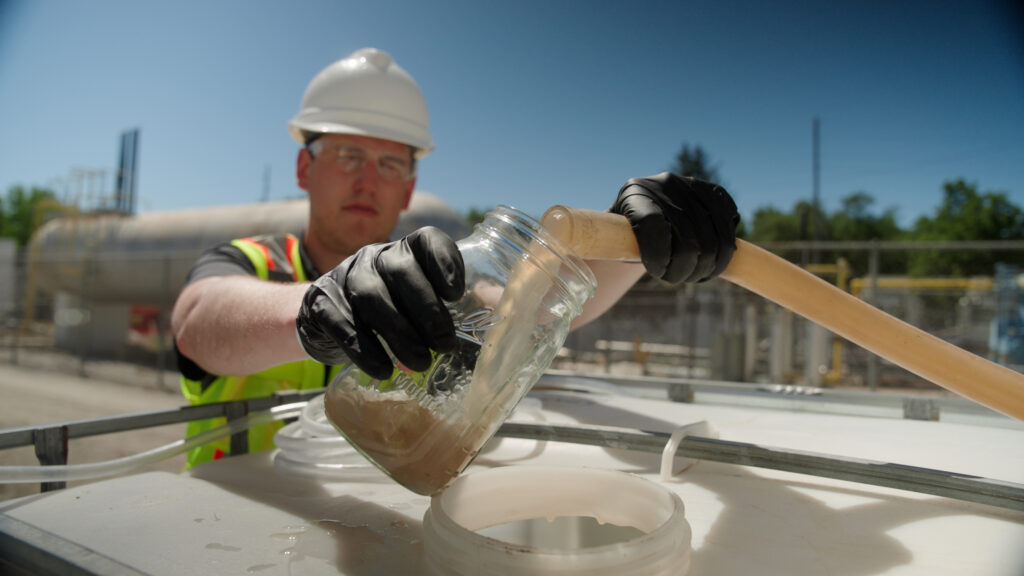In the industry of meat and poultry processing, maintaining food safety standards while optimizing operational efficiency is critical. One essential component of these operations is peracetic acid, or PAA, a highly effective antimicrobial agent. While PAA is widely used, many processors are missing out on a huge opportunity: reusing it.
 Most meat and poultry processors today still rely on a continuous cycle of using fresh water and adding more PAA, losing valuable process water and PAA that could otherwise be conserved and reused. This practice drives up operational costs, especially as processors face increasing pressures related to chemical use and freshwater availability. Reusing PAA can provide significant operational cost reductions, but to date, there has yet to be a reliable technology capable of delivering such benefits.
Most meat and poultry processors today still rely on a continuous cycle of using fresh water and adding more PAA, losing valuable process water and PAA that could otherwise be conserved and reused. This practice drives up operational costs, especially as processors face increasing pressures related to chemical use and freshwater availability. Reusing PAA can provide significant operational cost reductions, but to date, there has yet to be a reliable technology capable of delivering such benefits.
What Is PAA, and Why Is It Important?
PAA is widely used in the meat and poultry industry because of its antimicrobial properties and biodegradability. It helps processors comply with stringent food safety standards, ensuring consumer safety. The traditional approach of using PAA involves discarding used solution and process water, which means constantly replenishing both. This routine is costly, but many processors think it’s the only option.
Why PAA Reuse is Important
Antimicrobial Effectiveness
PAA’s role in ensuring food safety cannot be overstated. It is one of the most effective antimicrobials used in meat and poultry processing, capable of reducing a wide range of pathogens. It leaves no harmful residues, making it ideal for processors who need to meet strict food safety standards while reducing environmental impact.
Widespread Use in Processing Stages
PAA is used throughout meat and poultry processing, from surface sanitation to carcass rinses and chillers. It helps reduce microbial load and prevent contamination.
The Solution Meat & Poultry Processors Didn’t Know Was an Option
In many processing plants, the routine costs associated with chemicals and freshwater usage are often accepted as unavoidable. However, this perspective misses a crucial point—reusing PAA and water can drastically reduce OPEX. By continuing to operate without the ability to reuse, processors are unnecessarily increasing their chemical and freshwater expenditures, and, as a result, missing out on significant cost-saving opportunities.
Consider the impact of reusing water and PAA instead of continually replenishing them. This approach not only reduces the amount of chemicals you need to purchase, but it also decreases your reliance on freshwater—an increasingly costly and scarce resource. These savings are not just hypothetical – they are practical and achievable.
Why Now… And How?
The concept of reusing water in meat and poultry processing isn’t new, but past attempts to implement water reuse using membrane technologies have not been successful. Traditional membranes struggled with the high levels of fats, oils, and grease (FOG) in meat processing wastewater, leading to immediate clogging and maintenance issues. These technical challenges often prevent adoption of water reuse, despite the potential savings.
Recent advancements, however, have made it possible to overcome these challenges. With permeate that is free of total suspended solids (TSS), ZwitterCo’s technology sidesteps common issues like nozzle clogging and bacterial buildup, ensuring consistently high water quality that keeps systems running smoothly.
The Role of ZwitterCo Superfiltration (SF) in PAA and Water Reuse
ZwitterCo SF membranes, made with zwitterionic technology, are specifically engineered to handle the high organic loads found in meat and poultry process water, reducing over 95% of FOG and proteins. More importantly, ZwitterCo SF membranes, with their 1nm pore size, effectively filter out 99% of bacteria, pathogens, and TSS, while allowing small molecules like PAA to pass through into the clean permeate. This enables processors to recover more than 90% of these chemicals for reuse and recover over 95% of process water.
This allows processors to reuse water in various applications, such as screen wash and washdown areas, without the need for constant chemical replenishment. By reclaiming both PAA and process water, processors can drastically cut operational costs while maintaining food safety standards. These capabilities make ZwitterCo SF membranes uniquely suited for applications where both chemical and water reuse are priorities.
The Benefits of PAA Reuse with ZwitterCo
- Reduce OPEX via Water and Chemical Reuse
Reusing PAA allows processors to recycle both water and the antimicrobial, reducing the need to continuously add fresh PAA. This not only cuts chemical costs but also lowers demand for freshwater, which is crucial as water scarcity and costs rise. - Reduce Loading on Total Plant Wastewater
Another benefit of PAA and water reuse is the positive downstream impact on total plant wastewater. With ZwitterCo’s SF technology, over 95% of water can be reused, significantly reducing the volume of water that would otherwise enter the plant’s total wastewater. This also leads to additional savings on chemicals used for wastewater treatment.
ZwitterCo’s advanced superfiltration membranes offer a breakthrough in how meat and poultry processors manage their PAA and water resources. By enabling the reuse of over 90% of intervention chemistries and recovering over 95% of process water, ZwitterCo SF membranes provide a path to both significant cost savings and enhanced sustainability.
It’s time for the industry to rethink what’s “normal” in terms of OPEX and embrace the future of cost-effective, resource-efficient processing.
Interested in learning more about how ZwitterCo SF membranes can help your facility unlock hidden savings? Contact us today.

